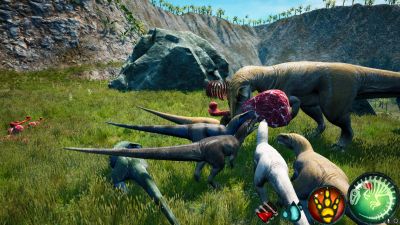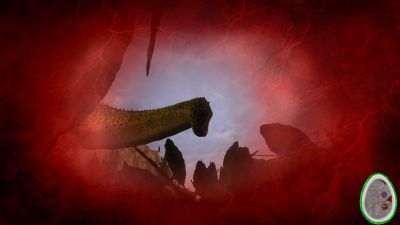Nesting
| Oops, something's missing! |
|---|
| It looks like this page is missing something - or maybe a lot of things! Beasts of Bermuda, despite its recent player increase, has had a very loyal following that didn't require a Wiki for the most part because of how tight-knit its community is. This means this Wiki has gone unmaned for a while now! Fear not, however, for there are still many resources out there while we try to update this site, such as our New Player Guide or the Official Discord Server. See you out there on the islands! |
Contents
What is Nesting?
Nesting is a mechanic in Beasts of Bermuda where a pair of users can create offspring. The nesting mechanic has unique benefits for both the parents and the children.
Mating, Gestation, & Laying the Egg

Mating
In order to mate, 2 mature (0.8+ growth) players of the same species but opposite genders must be close to each other and sent a Request to Mate. Once accepted, the two will lose all of their ability power and stamina as well as lie down. You can send a Request to Mate by:
- Opening the Players Menu (Tab) and clicking the Request to Mate button over their name bar
- Opening the Vocal Menu (hold down V) and hovering over the Request to Mate option while looking at the mate.
- Using the chat command \mate (nickname of the player you want to mate with).
Players can mate and lay as many eggs as they want including mating with different partners. The number of eggs given by the father is random, thought if the male invests into the Good Parent talent, he will be able to provide more eggs at once, up to a maximum of 6 per request.

Gestation
After mating, the female will receive an egg HUD in the top right of her screen (default UI layout) which will show the total amount of eggs gestating and how many have been gestated already. The egg icon will slowly fill up as more eggs finish gestating.
While gestating, the food and water of the mother will drain quicker, and her overall comfort will be lower. By investing into the Good Parent talent, these negative effects will be reduced. In order to lay any eggs, the father must create a nest (default "B") at the cost of ability power as long as the ground is even enough. Similarly to eggs, there is no limit to how many nests a male can create, but each nest has a limit of 25 eggs it can hold at once.
Laying Eggs
Eggs are laid by interacting with it (default "F"), and can be laid in multiple batches unless the players' species is Archelon, whose nest is covered up once the eggs are placed and will not accept more eggs. Eggs can only be laid inside of the mating partner nest and not yet used by another female.
Nests require maintenance and can be repaired by either parent by pressing the interact key while looking at the nest. Nests will visually deplete until they break, at which point all of the eggs are scattered, but can still be incubated and hatched out of as normal.
If, at any point, either the mother or the eggs are damaged, then the inherits of the child will have a higher likelihood to be negative.
Incubation & Hatching
For an egg to begin incubation, a player must be inside of it. On the Creature Select Menu, when creating a new creature, players are capable of requesting to become offspring. If a creature has an egg icon next to them, that means they have at least 1 available egg. The parents can choose to allow or dismiss anyone who requests to become offspring.
Once a player is inside an egg, it takes 10 minutes by default to be able to hatch, but this time can be reduced by:
- Providing the Incubation buff by sitting or lying over an egg
- Being inside a Great Nesting Site World Event
These can stack ontop of each other.
While inside the egg, the screen will slowly turn from bright red to a mostly visible window. Players can check their progress by looking at the egg icon on the bottom right or checking their growth inside the Character Menu. Once they reach 1.0, they can press the "Z" key to hatch. Hatchlings begin life at 0.1 growth, and will have a unique nested skin which will blend the two parent skins.
Aquatics that perform live birth (currently only Kronosaurus, Mosasaurus, and Elasmosaurus) skip the incubation process and instead birth players.
Nesting Perks
The above is up-to-date. Below this point are the outdated remains of this article.
There are a handful of perks to nesting; some are more impactive to gameplay, whereas others are more cosmetic. These include...
- Parental growth buff.
- Better inherits.
- Unique skins.
- DO BE WEARY, Incest and Damaged eggs can harm inherits.
Parental Buffs
Parents receive the Near Children buff from their nearby offspring who are below the growth of 0.8, which increases their growth speed.
Nesting Inherits
Players who are nested into the world of Beasts of Bermuda receive improved inherits. Inherits are set from the moment the egg is laid, based around the talent trees of the parents; with of course some random generation sprinkled on top. The bigger the parents are, the better the chances of good inherits.
While the talents the parents have affect what inherits their children may get, their personal inherits do not (with the exemption of Good Parent inherits). If a parent has +2 Nimble Footed, their children cannot earn Nimble Footed inherit from their parents, unless extreme random generation dictates so. This is incredibly rare.
Typically, a child has the potential to earn a +1 from each parent. With two +1s in the same talent, the offspring will receive a +2. If a pair has gone 3/3 in the same talent tree, chances of +2s in the given talents are far higher than an egg from parents with 3/3 in separate talent trees.
Unique Skins
When nested, players can get unique skins mixed from their parent's skins. This can result in any combination of colors and patterns, as it is possible to mix them all! On top of this, there are unique skin mutations that have a rare chance of appearing every now and again.
These mutations are...
- Bioluminescence - a glowing skin layer.
- Pure Albinism - a purely uncustomizable skin, mostly with light colors.
- Partial Albinism - a regular skin with a few, lightly colored uncustomizable layer(s).
- Pure Melanism - a purely uncustomizable skin, mostly with darker colors.
- Partial Melanism - a regular skin with a few, darkly colored uncustomizable layer(s).
Incest & Damaged Eggs
If the mother is damaged during gestation, the eggs may receive negative effects. Laid eggs that receive damage do not affect the inherits.
In addition, if a player takes an egg from an incest pair, their chances of receiving positive inherits are substantially lower, and they’ll be far more likely to gain negatives instead.